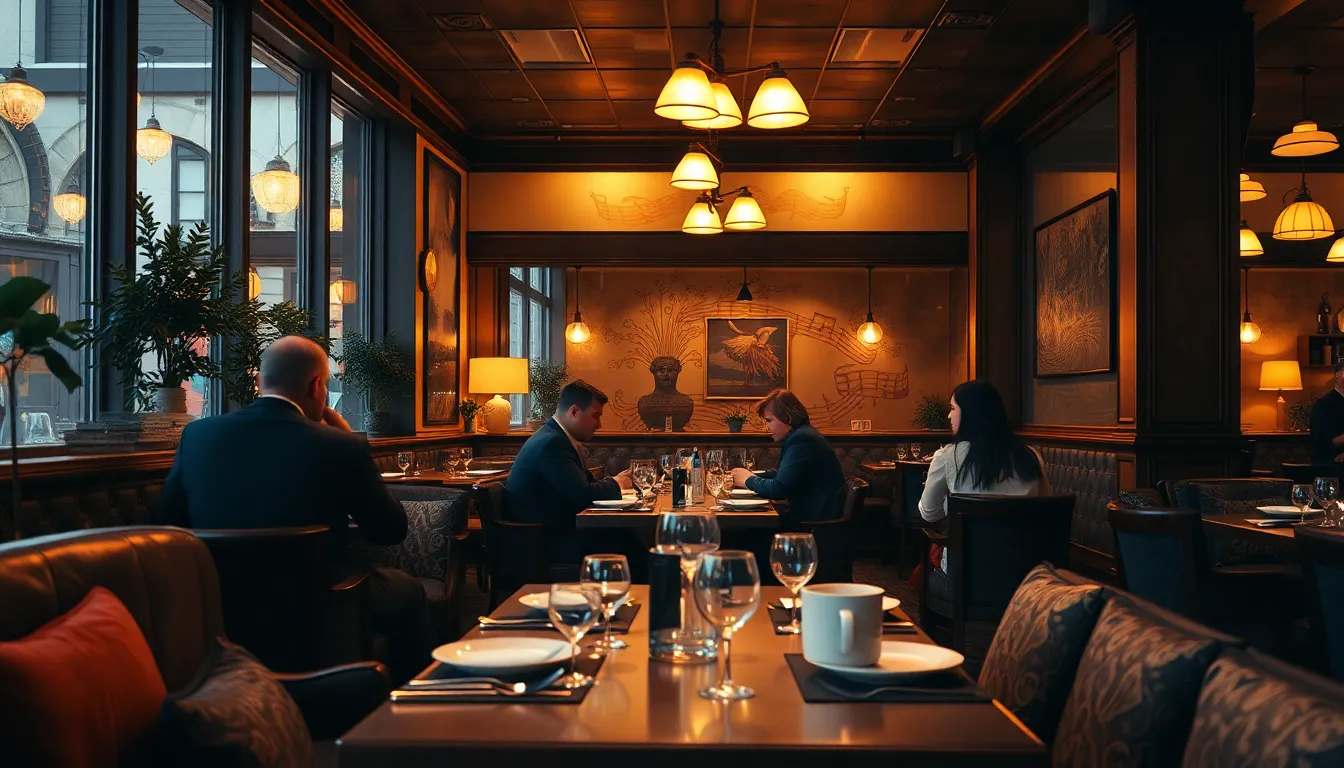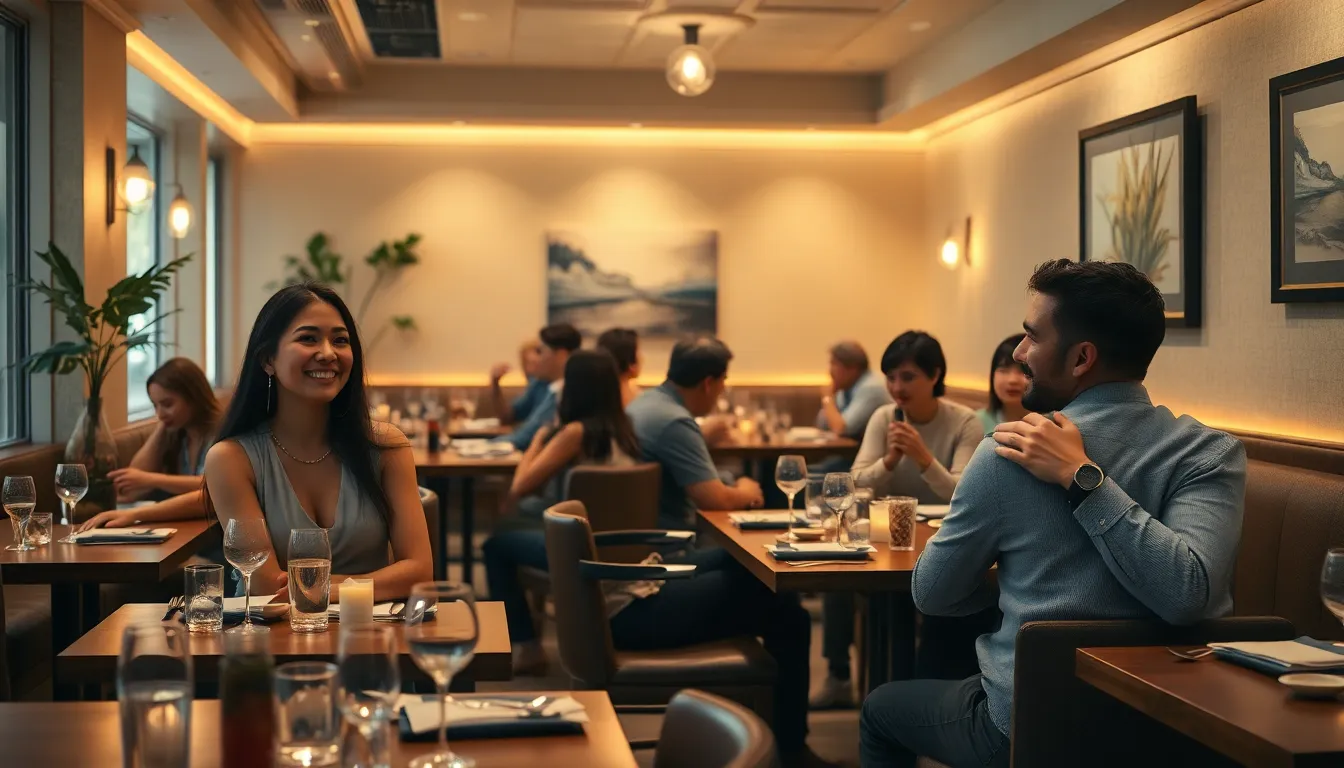The ambiance of a restaurant plays a crucial role in shaping the dining experience. It’s not just about the food; it’s about the atmosphere that surrounds it. From the lighting and decor to the music and layout, every element contributes to how guests feel and enjoy their meals. A well-crafted ambiance can transform a simple dinner into a memorable occasion.
In today’s competitive culinary landscape, restaurants must pay attention to these details to attract and retain customers. Ambiance can evoke emotions, influence perceptions of food quality, and even impact a diner’s willingness to return. Understanding the components of restaurant ambiance can help owners create spaces that resonate with their target audience, ensuring that each visit is not just a meal but an experience to savor.
Table of Contents
ToggleUnderstanding Restaurant Ambiance
Restaurant ambiance encompasses the elements that shape a diner’s overall experience. This includes lighting, decor, music, layout, and furnishings, which together create a distinctive atmosphere.
Definition of Restaurant Ambiance
Restaurant ambiance refers to the cumulative sensory experiences that guests encounter during their visit. Key components include:
- Lighting: Varying levels of brightness set the mood and highlight different areas.
- Decor: The style and theme contribute to the restaurant’s identity and brand.
- Music: Background sounds influence how guests perceive the dining experience and meal enjoyment.
- Layout: The arrangement of tables and flow of the space impacts comfort and intimacy.
Importance of Atmosphere in Dining
Atmosphere significantly affects diners’ emotions and perceptions. Studies indicate diners are likely to spend more time—and money—in well-designed spaces. Benefits of a carefully curated atmosphere include:
- Enhanced Enjoyment: Positive sensory experiences elevate meal satisfaction.
- Memorable Experiences: Unique ambiance creates lasting memories, encouraging repeat visits.
- Perceived Food Quality: Ambiance can influence how guests evaluate the freshness and taste of their meals.
- Emotional Connection: A welcoming atmosphere fosters connections, enhancing social interactions.
Investing in restaurant ambiance is essential for attracting and retaining patrons, ultimately contributing to the establishment’s success in a competitive market.
Key Elements of Restaurant Ambiance

Key elements like lighting, music, and furniture shape the restaurant atmosphere. Each component contributes to the overall experience, influencing diner satisfaction and engagement.
Lighting
Lighting plays a crucial role in creating the desired ambiance. It impacts mood, enhances visual appeal, and influences food presentation. Soft lighting can create intimacy in fine dining settings, while brighter lights might suit casual eateries. Incorporating adjustable lighting options allows for adaptability during different times of day or events. Use warm tones to evoke comfort and relaxation, promoting a welcoming environment.
Music and Sound
Music and sound significantly affect how patrons perceive their dining experience. Upbeat tempos can energize a lively atmosphere, while softer melodies enhance relaxation in quieter settings. Volume levels should align with the dining style—loud enough to enjoy but soft enough to facilitate conversation. Consistency in music selection helps establish a brand identity, fostering familiarity and comfort for returning guests.
Furniture and Decor
Furniture and decor contribute to the restaurant’s thematic expression and comfort. Comfortable seating encourages longer visits, while cohesive design elements—color palettes, materials, and styles—create an engaging visual experience. Attention to details, such as artwork and table settings, further reinforces the restaurant’s identity. A well-planned layout promotes smooth traffic flow and enhances the overall dining experience by ensuring patrons feel at ease.
Impact of Restaurant Ambiance on Customer Experience
Restaurant ambiance significantly shapes customer experiences. A well-crafted atmosphere influences behavior and enhances satisfaction.
Creating First Impressions
Creating first impressions relies heavily on the initial sensory impacts of a restaurant. Elements such as lighting, decor, and overall design immediately communicate a restaurant’s identity and values. For example, dim lighting in upscale restaurants conveys intimacy and sophistication, whereas vibrant colors and bright lights in casual eateries signal energy and warmth. A striking entranceway or thematic decor also captures attention, making guests feel welcomed and intrigued. Research indicates that 60% of diners form an opinion within the first few minutes of their arrival, illustrating the critical nature of ambiance in shaping expectations.
Enhancing Dining Satisfaction
Enhancing dining satisfaction hinges on the harmonious integration of ambiance elements. Comfortable seating arrangements allow guests to relax and enjoy their meals, while suitable music complements conversation without overwhelming it. A study revealed that diners exposed to soft music tend to linger longer and savor their dining experience, leading to increased spending. Similarly, strategic lighting influences how food is perceived; well-lit dishes enhance visual appeal, elevating perceived quality. By creating an atmosphere that prioritizes comfort and engagement, restaurants can ensure that guests leave satisfied and eager to return.
Trends in Restaurant Ambiance
Current trends in restaurant ambiance demonstrate a shift toward creating unique and engaging experiences for diners. Modern designs and cultural influences play significant roles in shaping these trends.
Modern Design Approaches
Modern design approaches emphasize minimalism, sustainability, and technology integration.
- Minimalist Aesthetics: Many restaurants adopt clean lines, open spaces, and neutral color palettes to promote a sense of calm. Minimal design encourages focus on the dining experience rather than distractions.
- Sustainable Materials: The use of eco-friendly materials like reclaimed wood and recycled metal reflects a growing emphasis on sustainability. This approach resonates with environmentally conscious diners.
- Technology Integration: Technology enhances the ambiance through features like smart lighting systems and digital menus. These innovations can adapt to the time of day, creating a dynamic atmosphere.
Cultural Influences on Ambiance
Cultural influences significantly shape restaurant ambiance, reflecting global trends and local traditions.
- Thematic Experiences: Restaurants often incorporate cultural themes into their decor and overall concept. These themes can transport diners to different places, enhancing immersion.
- Local Art: Showcasing local artists and craftsmen allows restaurants to celebrate regional culture. This approach not only enriches the ambiance but also supports the local community.
- Cuisine-Inspired Decor: Decor that reflects the cuisine being served fosters authenticity. For example, a Mediterranean restaurant might feature influences from traditional Mediterranean architecture, promoting a cohesive dining experience.
Restaurant ambiance is more than just a backdrop; it’s a vital component that shapes the entire dining experience. By thoughtfully curating elements like lighting, music, and decor, restaurants can create an inviting atmosphere that resonates with guests. When diners feel comfortable and engaged, they’re more likely to enjoy their meals and return for future visits.
As trends evolve towards minimalism and sustainability, restaurants have the opportunity to innovate while still prioritizing the emotional connections formed through ambiance. A well-designed space not only enhances satisfaction but also encourages patrons to linger longer, ultimately benefiting the establishment’s bottom line. Investing in ambiance is investing in the overall success of the dining experience.





